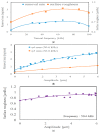Ultrasonic Vibration Assisted Electro-Discharge Machining (EDM)-An Overview
- PMID: 30744142
- PMCID: PMC6384716
- DOI: 10.3390/ma12030522
Ultrasonic Vibration Assisted Electro-Discharge Machining (EDM)-An Overview
Abstract
Many of the industrial processes, including material removal operation for shape generation on the surface of material, exploit the assistance of ultrasonic vibrations. This trend of using ultrasonic vibration in order to improve the process performance is becoming more and more prominent recently. One of the significant applications of this ultrasonic vibration is in the industrial processes such as Electro-discharge machining (EDM), where ultrasonic vibration (UV) is inserted as a medium for enhancing the process performance. Mostly ultrasonic vibration is applied along with the EDM process to increase the efficiency of the process through debris cleansing from the sparking gap. There have been significant changes in ultrasonic assisted technology during the past years. Due to its inherent advantages, ultrasonic assistance infiltrated in different areas of EDM, such as wire cut EDM, micro EDM and die sinking EDM. This article presents an overview of ultrasonic vibration applications in electric discharge machining. This review provides information about modes of UV application, impacts on parameters of performance, optimization and process designing on difficult-to-cut materials. On the bases of available research works on ultrasonic vibration assisted EDM, current challenges and future research direction to improve the process capabilities are identified. Literature suggested improved material removal rate (MRR), increased surface roughness (SR) and tool wear ratio (TWR) due to the application of ultrasonic vibration assisted EDM. However, tool wear and surface roughness can be lessened with the addition of carbon nanofiber along with ultrasonic vibration. Moreover, the application of ultrasonic vibration to both tool and workpiece results in higher MRR compared to its application to single electrode.
Keywords: EDM; hard to cut materials; material removal rate; surface roughness; ultrasonic vibration.
Conflict of interest statement
The authors declare no conflict of interest.
Figures
















































References
-
- Ho K., Newman S. State of the art electrical discharge machining (EDM) Int. J. Mach. Tools Manuf. 2003;43:1287–1300. doi: 10.1016/S0890-6955(03)00162-7. - DOI
-
- Leão F.N., Pashby I.R. A review on the use of environmentally-friendly dielectric fluids in electrical discharge machining. J. Mater. Process. Technol. 2004;149:341–346. doi: 10.1016/j.jmatprotec.2003.10.043. - DOI
-
- D’Urso G., Giardini C., Quarto M. Characterization of surfaces obtained by micro-EDM milling on steel and ceramic components. Int. J. Adv. Manuf. Technol. 2018;97:2077–2085. doi: 10.1007/s00170-018-1962-5. - DOI
-
- D’Urso G., Giardini C., Maccarini G., Quarto M., Ravasio C. Analysis of the surface quality of steel and ceramic materials machined by micro-EDM; Proceedings of the 18th International Conference of the European Society for Precision Engineering and Nanotechnology, EUSPEN 2018; Venice, Italy. 4–8 June 2018; pp. 431–432.
-
- Zhang J., Lee T., Wu C., Tang C. Surface integrity and modification of electro-discharge machined alumina-based ceramic composite. J. Mater. Process. Technol. 2002;123:75–79. doi: 10.1016/S0924-0136(02)00065-1. - DOI
Publication types
Grants and funding
LinkOut - more resources
Full Text Sources
Research Materials
Miscellaneous

